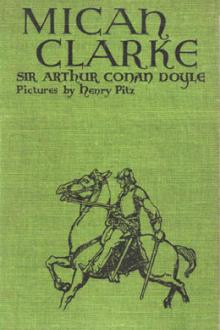Three Thousand Years of Mental Healing, George Barton Cutten [crime books to read TXT] 📗

- Author: George Barton Cutten
- Performer: -
Book online «Three Thousand Years of Mental Healing, George Barton Cutten [crime books to read TXT] 📗». Author George Barton Cutten
The pride of the demon was also to be wounded by the use of the vilest-smelling drugs, by trampling underfoot and spitting upon the picture of the devil, or even by sprinkling upon it foul compounds. Some even tried to scare the demon by using large-sounding words and names.
The third method of exorcism was punishment. The attempt was frequently made to scourge the demon out of the body. The exorcism was more effective if the name of the demon could be ascertained. If successful in procuring the name, it was written on a piece of paper and burned in a fire previously blessed, which caused the demons to suffer all the torments in the accompanying exorcisms. All forms of torture were employed, and in the great cities of Europe, "witch towers," where witches and demoniacs were tortured, and "fool towers," where the more gentle lunatics were im prisoned, may still be seen. The treatment of the insane in the Middle Ages is one of the darkest blots on the growing civilization.
The exorcism being completed, when some of the weaker demons were put to flight an after service was held in which everything belonging to the patient was exorcised, so that the demon might not hide there and return to the patient. The exorcised demons were forbidden to return, and the demons remaining in the body were commanded to leave all the remainder of the body, and to descend into the little toe of the right foot, and there to rest quietly.
After the Reformation, two contests shaped themselves in the matter of exorcisms. The Protestants and the Roman Catholics vied with each other in the power, rapidity, and duration of the exorcisms. Both put forth miraculous claims, and with as much energy denied the power of the other. They agreed in one thing, and that was the erroneous position and teaching of the physicians. This, however, was but a continuation of that rivalry between the advancement of science and the conservation of theology, which is as old as history. In our examination of the influence of Christianity upon mental healing, it may be well for us to glance at the discouraging attitude of Christianity toward medicine.16
The usurpation of healing by the church, which was a most serious drawback to the therapeutic art, will be traced in the following chapters; there are, however, some other ways in which the church retarded the work of physicians. Chief among these was the theory propagated by Christians that it was unlawful to meddle with the bodies of the dead. This theory came down from ancient times, but was eagerly accepted by the church, principally on account of the doctrine of the bodily resurrection. In addition to this, surgery was forbidden because the Church of Rome adopted the maxim that "the church abhors the shedding of blood." A recent English historian has remarked that of all organizations in human history, the Church of Rome has caused the spilling of most innocent blood, but it refused to allow the surgeons to spill a drop.
Monks were prohibited the practice of surgery in 1248, and by subsequent councils, and all dissections were considered sacrilege. Surgery was considered dishonorable until the fifteenth or sixteenth centuries. The use of medicine was also discouraged. Down through the centuries a few churchmen and many others, especially Jews and Arabs, took up the study. The church authorities did everything possible to thwart it. Supernatural means were so abundant that the use of drugs was not only irreligious but superfluous. Monks who took medicine were punished, and physicians in the thirteenth century could not treat patients without calling in ecclesiastical advice.
We are told that in the reign of Philip II of Spain a famous Spanish doctor was actually condemned by the Inquisition to be burnt for having performed a surgical operation, and it was only by royal favor that he was permitted instead to expiate his crime by a pilgrimage to the Holy Land, where he died in poverty and exile.
This restriction was continued for three centuries, and consequently threw medical work into the hands of charlatans among Christians, and of Jews. The clergy of the city of Hall protested that "it were better to die with Christ than to be cured by a Jew doctor aided by the devil." The Jesuit professor, Stengal, said that God permits illness because of His wish to glorify Himself through the miracles wrought by the church, and His desire to test the faith of men by letting them choose between the holy aid of the church and the illicit resort to medicine.
There was another reason for the antagonism of the church to physicians; the physicians in this case were inside the church. The monks converted medicine to the basest uses. In connection with the authority of the church, it was employed for extorting money from the sick. They knew little or nothing about medicine, so used charms, amulets, and relics in healing. The ignorance and cupidity of the monks led the Lateran Council, un der the pontificate of Calixtus II, in 1123, to forbid priests and monks to attend the sick otherwise than as ministers of religion. It had little or no effect, so that Innocent II, in a council at Rheims in 1131, enforced the decree prohibiting the monks frequenting schools of medicine, and directing them to confine their practice to their own monasteries. They still disobeyed, and a Lateran Council in 1139 threatened all who neglected its orders with the severest penalties and suspension from the exercise of all ecclesiastical functions; such practices were denounced as a neglect of the sacred objects of their profession in exchange for ungodly lucre. When the priests found that they could no longer confine the practice of medicine to themselves, it was stigmatized and denounced. At the Council of Tours in 1163, Alexander III maintained that through medicine the devil tried to seduce the priesthood, and threatened with excommunication any ecclesiastic who studied medicine. In 1215, Innocent III fulminated an anathema against surgery and any priest practising it. Even this was not effectual.17
What we see in connection with dissection and surgery and medicine was repeated at a later date with inoculation, vaccination, and anæsthetics. There were the same objections by the church on theological grounds, the same stubborn battle, and the same inevitable defeat of the theological position.
So long as disease was attributed to a demoniacal cause, so long did exorcisms and other miraculous cures continue, and so far as these cures were efficacious, they must be classed as mental healing. Probably they continued longer in insanity and mental derangement on account of the beneficent and soothing effect of religion upon a diseased mind. Priestly cures of all kinds were largely, if not wholly, suggestive, and no history of mental healing would be complete without a résumé of ecclesiastical therapeutics. Many vagaries of healing which the church introduced might be mentioned to show to what extent the people may be misled in the name of religion. For example, the doctrine of signatures, to be later discussed, was disseminated by priests and monks, and if these medicines were ever effective it must have been by mental means.
The demon theory of disease, which began before the age of history, and continued down through the savage ages and religions, through the early civilizations, through the gospel history, and dominated early Christianity, was finally, in the sixteenth century, to be vigorously assailed and largely overcome. The cost of this was considerable; attached as it was to the Christian church, it seemed necessary to destroy the whole Christian fabric in order to unravel this one thread. Atheism, therefore, was rampant, and science and atheism became almost synonymous, and continued so until the church freed science from its centuries of bondage and allowed it to develop so as to be again in these days a co-laborer.
In pleasing contrast to the destructive and deterrent efforts of the church against the development of medicine is the helpful care of the sick exercised by Christians. The example of Jesus as shown by his tender sympathy, his helpful acts, and his instruction to his followers, bore fruit in the relief and care of sufferers by individuals and religious asylums. About the year 1000 and later, the infirmaries which were attached to numerous monasteries, and the hospitia along the routes of travel which opened their doors to sick pilgrims, were but the development of a less portentous attempt on the part of individuals and societies to care for the sick. The Knights of St. John, or the Hospitalers as they were called, assumed as their special duty the nursing and doctoring of those in need of such attention, especially of sick and infirm pilgrims and crusaders.
Hospitals for the sick, orphanages for foundlings, and great institutions for the proper care of paupers developed with immense strides, and during the twelfth century expanded into gigantic proportions. In the ensuing age, the mediæval mind was fired with a faith in the efficacy of unstinted charity; members of society, from holy pontiff to the hum blest recluse by the wayside, rivalled each other in gratuities of clothing and food, founding of hospitals, and endowment of beneficent public institutions. St. Louis's highest claim to pious glory arose from his restless and unstinted charities to the indigent and sick. Even the lepers, which were shunned or segregated, were treated by Christian institutions; and saints and saintesses found pious expression for their humility in personal attendance and even loving embraces of these unsightly beings covered with repulsive sores. For the last millennium there has not been a time when Christian love and benevolence have not sought the opportunity of ministering to the sick.
One can easily recognize the effect which this fact would have on mental healing. The church fostered the ideas of exorcism and the cures by relics and shrines, and deprecated the use of medicine. If the hospitals and infirmaries were almost wholly in the hands of the monks and churchmen, there was little hope for the development of other than ecclesiastical mental healing. The untold good which Christian ministrations to the sick accomplished must be acknowledged, but it was not an unmixed benefit to the race as a whole.
We may more easily see, perhaps, the connection between the church and the development of medicine, and the despotic power of the church in this regard, when we remember that physicians were formerly a part of the clergy, and it was not until 1542 that the papal legate in France gave them permission to marry. In 1552 the doctors in law obtained like permission. An early priestly physician has survived to fame by the name of Elpideus, sometimes confused with Elpidius Rusticus. He was both a deacon of the church and a skilled surgeon, and was very favorably mentioned by St. Ennodius as a person of fine culture. He was sufficiently dexterous and skilful to heal the Gothic ruler, Theodoric, of a grievous illness.18 Salverte gives us additional examples: "Richard Fitz-Nigel, who died Bishop of London, in 1198, had been apothecary to Henry II. The celebrated Roger Bacon, who flourished in the thirteenth century, although a monk, yet practised medicine. Nicolas de Farnham, a physician to Henry III, was created Bishop of Durham; and many doctors of medicine were at various times elevated to ecclesiastical dignities."19
The grip of the church accomplished its purpose, and science, especially the science of medicine, was strangled, almost to the death. Even the people





Comments (0)